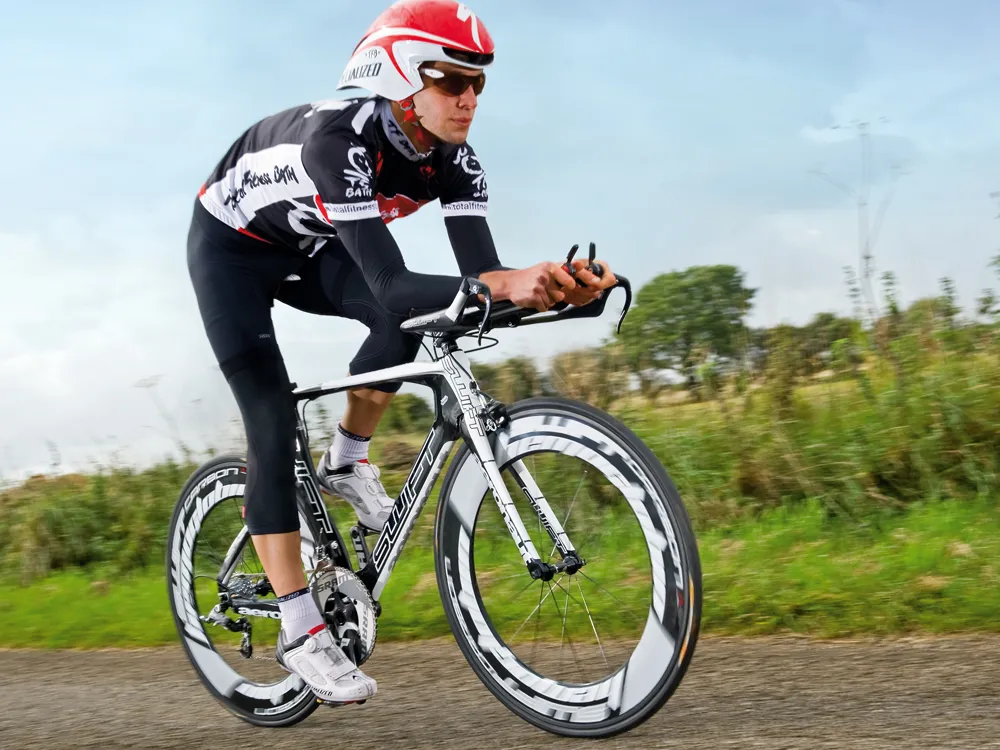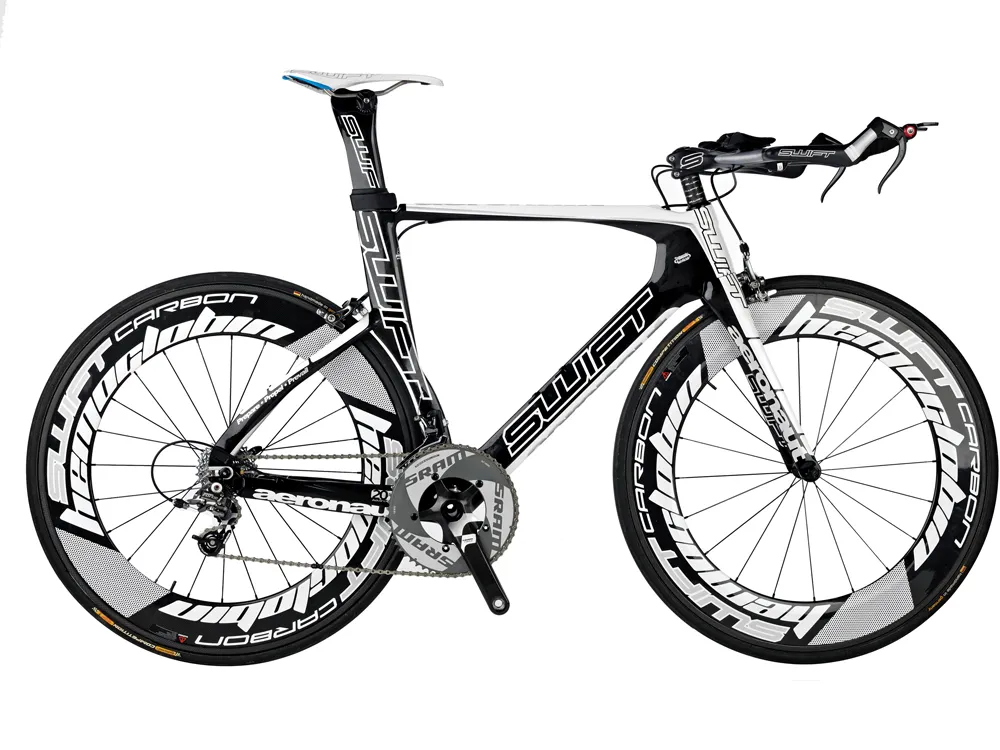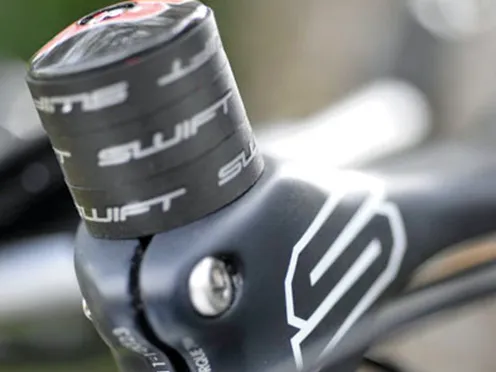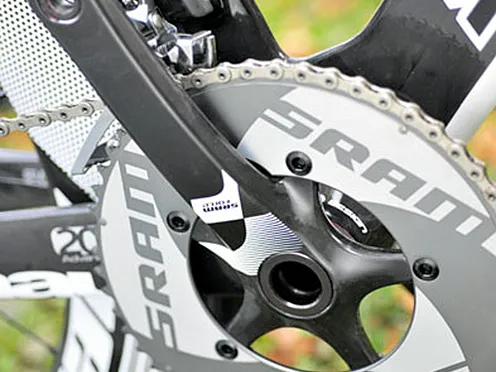Swift Carbon are a relatively young South African company with ambitious aims to become one of the best boutique brands around. Does the distinctive Aeronaut frame and cockpit put them right on track for the top?
It certainly gets a nod for putting in a solid, contemporary speed bike performance. It wasn't as lively on the climbs or out of the corners as some, although its composure at speed does make it a convincing package.
Ride & handling: A naturally fast, communicative and surefooted handling machine
While the cockpit might not be the most solid piece of hand hardware we’ve had hold of, there’s no denying the authoritative nature of the front end of the frame underneath. Not only are forks and head tied together well for a clear and consistent communication of steering intent and result, but there’s plenty of beef at the back as well. The oversized bottom bracket, big BB30 crank axle and monolithic chainstays create a rock-solid drive connection to the suitably solid dropouts. In short, whatever pressure you can put through the sole of your shoe is clearly seen in steadily rising speed. We’d definitely categorise it as steadily rising speed though, as there’s a noticeable lack of snap to the acceleration.
Deep wheels always dull acceleration to a certain extent, but the frame itself is also slightly heavy for its price. There’s also a sense of dislocation around the top of the seat tube/top tube – unsurprising given the structural notch there. This can ‘give’ noticeably if you’re really wrestling the bike front to rear out of the saddle, and there’s some rear-wheel steer if you properly push it through smooth, grippy corners. The long wheelbase also means that even with the weight forward and using potentially gusty slab-sided deep-section rims, we rarely had to fight the front end for control. Even dropped deep into a straightline tuck as speeds slid off the far end of spinnable gears, we never felt nervous or compelled to sit up and self air brake.
Even with conventionally mounted callipers, fine brake control and full stopping power is still sacrificed in favour of cleaner internal cable routing. This inevitably impacts on rider confidence on the more rollercoaster or hard-braking/accelerating short-course situations, where the slightly dull acceleration was also apparent again. Greater vibration transmission than some other carbon bikes we've ridden was also noticeable on longer rides, and we’d definitely be switching the saddle and taping the bars sharpish if this was our own bike rather than a test sample.
Frame: Tapered headtube and press-fit bottom bracket add stiffness
The headtube is interesting straightaway, with a broad ‘forehead’ wrapping round the top. It then swells out gradually underneath, with an extended web behind for smoothing airflow. Apparently it uses ‘Totemic Filament Technology’ too though we’re not sure what that actually means. We do know they use ultra-high modulus Japanese carbon and German resins though.
Brakes are mounted conventionally, but the cables are tucked inside behind the stem, and the seatpost clamp gets a rubber cover, which is a nice touch in wet races. The blunt front edge isn’t the most aero of profiles though. The downwards dog-leg of the tapering top tube leaves a very narrow, right-angled cut out, which is generally a situation most carbon-fibre designers do their utmost to avoid. The lower wheelhugger section of the seat tube is relatively narrow too, although the massive pressfit bearing bottom bracket shell extends upwards a fair way to both reinforce it and reduce drag though.
Deep chainstays are below axle level with wheel position in the long horizontal sliders adjusted via brass-collared bolts. Seat stays are also connected low to create an elongated cross section, before fattening up and curving down to connect to the dropouts. The seatpost itself gets a two-position top for the clamp to make it UCI compliant and still allow a forward tri-style seat position. Even allowing for the amount of internal cabling, it’s a pretty hefty structure too.
Equipment: Comes in a ‘pod’ format with seatpost, fork and cockpit included
The Aeronaut comes in a ‘pod’ format with seatpost, fork and cockpit included. The distinctive ‘Manta Ray’ design with blended stem and flush-mounted arm pads certainly means minimum airflow disturbance and steeply rising front sections provide a very secure feel on descents. Despite a rough ride through your hands there’s still a lot of flex and bounce up front when you’re out of the saddle however.
Swift’s Hemoglobin wheels reinforce the riot of logos look, but they’re an uncompromising 88mm deep including the carbon brake track. They’re tubular (glue-on rather than hook on clincher-styles) specific too, which makes them best suited to confident and skilled riders rather than novice or dodgy-weather friendly. There’s brake rub and some sideways twang when worked hard through the pedals or corners.





